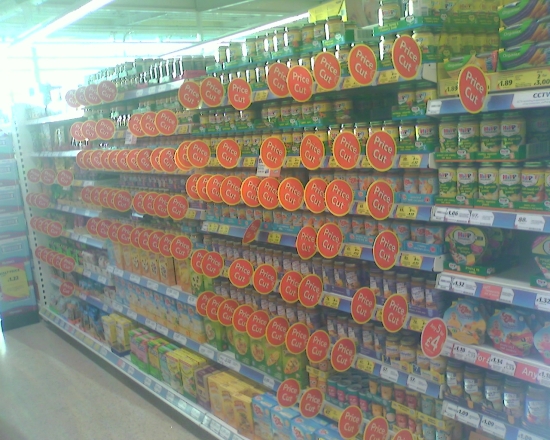Shoppers in the current economic climate will do anything for a bargain. Disposable income remains low, meaning that shopping for luxuries is a pastime few can afford. Of course, this is having a profound effect upon retailers, many of which are struggling to post profits for the year.

Tesco is one supermarket chain feeling the effects of the recession. Once one of the most successful businesses operating within the UK, largely thanks to its monopolisation of retail space to create “Tesco Towns”, the grocery retailer has seen its fortunes change drastically in recent years. Although still successful, in that it remains the most popular supermarket brand in the country, competition from rivals such as Asda, Sainsbury’s and Morrisons has seen profit margins steadily falling since the start of the recession in 2008.
Following a shock profit warning released earlier in this financial year, the retailer has been forced to post a 12 per cent drop in group earnings upon the conclusion of the second quarter this week. While a £1 billion turnaround plan launched following the profit warning has begun to have a positive effect on sales, Tesco still has a long way to go, especially as rival chain Sainsbury’s announced the addition of extra sales in conjunction with the end of the first half of the financial year.
Although UK sales have now started upon the slow path to recovery, the group’s Asia and Europe branches failed to perform to the same level. Of course, the Eurozone crisis still gripping much of Tesco’s international market goes a long way to explain this, while shopping hour restrictions in South Korea dented growth in the East.
This all contributed to international sales dropping by 17 per cent, with Tesco posting a total of £378 million in international trading profits.
And while UK sales have picked up, investment in the turnaround plan did eat into much of the profits generated in the year so far. Since January, Tesco has recruited 8,000 additional staff, refurbished 230 stores and completely redesigned its “Everyday Value” range – all of which has cost a significant amount to implement.
Philip Clarke, chief executive of Tesco Plc, said; “In April, I set out our plans to ‘Build a Better Tesco’ in the UK.
“We have been hard at work and I am encouraged by our customers’ initial responses to the changes we have made – but there is much more to be done.”
UK like for like sales for the brand, which excludes fuel and VAT, grew by 0.1 per cent in the past three months. While this may not seem like much of a success, it is extremely positive when compared to the 1.5 per cent decline witnessed in the first quarter of trading in this financial year.
In fact, the second quarter’s small growth is the first positive quarterly result Tesco has seen for quite some time, following six consecutive quarters of declining like for like sales.
However, Tesco’s small success is overshadowed by the half year performance of rival chain Sainsbury’s. The supermarket chain posted a 1.7 per cent rise in like for like sales, including a near double digit growth in its high end “Taste the Difference” range which has proven to be hugely popular. Sainsbury’s also performed well in the sale of non-food items such as clothing, possibly fuelled by the release of an exclusive range by TV fashion guru Gok Wan in stores late last year.
It seems, then, that despite the changes to Tesco commercial properties and a revamp of ranges to attract customers, Tesco is still putting a foot wrong somewhere. While other brands have grown consistently, the UK’s largest grocery retailer is struggling to hike sales and draw custom.
Phil Dorrell of Retail Remedy, a leading retail consultant, believes that Tesco could benefit hugely from following the example of one of its biggest rivals.
He says; “Sainsbury’s is steaming ahead in a seriously tough market. The retailer’s outperformance is a result of clear strategy that has been very well executed.
“With a solid focus on delivering an improved shopping experience and a marketing team that are in tune with their shoppers, Sainsbury’s are showing Tesco how it should be done.”
Do you think that, after so many years at the top of the ladder, Tesco’s recent bad fortune is simply down to the transitional nature of the retail industry? Or do you think that, once the economic situation is resolved in the UK, Tesco will be able to recover and go back to being the UK’s primary grocery retailing giant?
Previous Post
Irish Commercial Property Outlook Positive